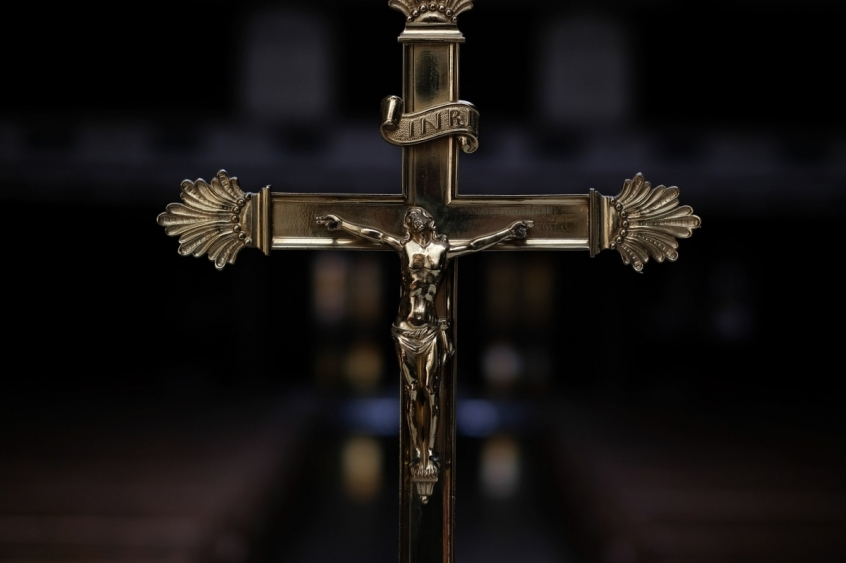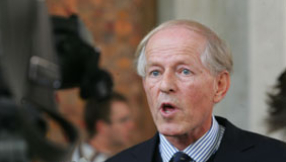
Had you been in Basel, Switzerland, in 1529, you would have witnessed a most extraordinary and shocking sight. One morning, an enthusiastic crowd dragged the large crucifix down from its place within the cathedral. The crucifix was, and is, an image of Jesus on the cross, as distinct from a bare or empty cross.
Having paraded the crucifix from the cathedral to the marketplace, those responsible taunted it with the words, "If you are God, help yourself; if you are man, then bleed!" The crucifix did neither and was destroyed.
Those abusing the crucifix at Basel were not alone and what occurred there was no isolated incident. In 1523, at Pirna, Germany, it is recorded that a man spat on the crucifix. At Ulm, Germany, in 1534, another man abused the crucifix. Neither were punished. Indeed, those around clearly approved of these terrible acts. Other crucifixes were smashed or torn apart, or the image of Jesus was beheaded. Still others were mocked by being carried in carnivals as objects of derision.
The ideological reasoning behind the destruction
What motivated these shocking attacks was a rejection of the Catholic Church's veneration of these objects, and a repudiation of the beliefs that had grown up around them. For example, it was claimed that some crucifixes bled, in imitation of Christ's wounds. Such ideas were found in local folklore as well as in official Catholic claims. All such ideas were resolutely rejected by Protestants as they sought to purify the church of beliefs they regarded as superstition and idolatry.
Many historic English parish churches still bear the scars of where "rood screens" were torn out and destroyed during the reign of Edward VI (1547-53). These ornate partitions between the chancel and nave were named from the "rood" (an Old English word for "cross"), which surmounted the screen with a large figure of the crucified Christ. Edward VI was an enthusiastic Protestant reformer – unlike his father, Henry VIII – and it was during his rule that stained glass windows in churches were smashed, wall-paintings whitewashed, and crucifixes chopped up and burned. Figural decoration was banished from churches.
This was not just vandalism but, instead, was driven by a desire to remove decorations that were considered idolatrous, and which had often become objects of veneration. Demolition of the rood screen was also done to remove any separation between clergy and laity. Nevertheless, there is still the deeply disturbing thought of carvings of Jesus hanging from the cross being consigned to the axe and the flames.
Arguably, the pendulum swung violently too far in the other direction to what was being opposed. As so often in church history the reaction to problems was extreme. As the saying goes: "Baby was thrown out with the bath water." While later generations rediscovered the value of some decoration, it was austerity that was bequeathed to us. And the crucifix never really recovered from this.
However, not all Protestants were comfortable with these attacks on crucifixes. Early Lutherans did not emulate the more extreme Swiss Reformed Protestants, since Lutherans usually exempted crucifixes from the ban on images appearing in churches. In fact, Luther even found on one occasion that pieces of a broken crucifix had been scattered, by more extreme Protestants, about a pulpit from which he was due to preach. These believers were determined to strip the figure of Christ from the cross. It was reported from Berlin that when enthusiastic Calvinists tore down and smashed the crucifix that had hung in the richly decorated cathedral, in 1613, it was Lutherans who wept and complained, "that the likeness of our God was treated with so little mercy."
Out of this historic turmoil arose a division over the portrayal of the cross that endures until today. In Catholic churches we see Christ on the cross; in Protestant churches the cross is usually empty. There are exceptions, of course, but the pattern is clear.
The legacy of the empty cross
We 21<sup>st-century evangelicals have inherited the empty cross. Only this last weekend, while leading the Palm Sunday service at a local church, I quickly counted three crosses around the church – a brass one on the communion table and two wooden ones at other places. And we had our palm crosses to take home. All the crosses, of course, were empty.
We might posit a simple 'Cross Rule" that goes something like this: The more enthusiastically evangelical a community is, the less likely it is that we will find Christ on the cross.
Now there is good theology behind the idea of the "empty cross." While the crucifixion of Jesus is central to our understanding of the nature and cost of salvation, we confidently affirm our belief in his resurrection on Easter morning. Consequently, both the cross and the tomb are empty. The "empty cross" reminds us of that.
A radical suggestion...
However, there is a downside to the empty cross. Such a cross is easy to make aesthetically pleasing. Simple brass, nicely turned wood, bright gold, all make for an appropriate symbol. Yet they lack the ability to communicate the raw and shocking nature of the cost of salvation. Interestingly enough, we can cope with this in film, but recoil from it when designing our churches, worship spaces, or our personal jewellery.
Maybe it is time to recall the wisdom of the writer of Ecclesiastes: "For everything there is a season, and a time for every matter under heaven" (Ecclesiastes 3:1). Maybe there is a season when we evangelicals should replace our empty crosses with a crucifix and meditate more on the shocking cost of salvation. Visually, a crucifix could help us do this. There are many vivid paintings to choose from, for vast numbers of believers over the centuries have not shared the aversion to looking at Christ on the cross as part of their worship.
For some of us that would be an artistic revolution, almost a cultural earthquake. But then, what happened on Good Friday was controversial, shocking, disturbing. These emotions and reactions go with the territory. They are hardwired into the event.
While we are debating the pictorial and theological merits of this suggestion, there are other sisters and brothers who find that the man on the cross speaks powerfully to their lived experience.
The man on the village tree
Within the Hindu caste system, Dalits are the so-called polluting "untouchables," existing in poverty outside the hierarchy of religious purity. In the 1970s, poor and outcast Christians adopted this name (meaning "broken") as an expression of their oppressed status within Indian society, and also within the minority Indian Christian community over 400 years.
Between 1975 and 1986 a new form of liberation theology arose, centred upon Dalit problems regarding poverty and discrimination. The crucified Christ is central to Dalit theology, as they see in Jesus' crucifixion his full humanity. Christ is understood as a Dalit both in his suffering to redeem humanity and also in his apparent God-forsakenness upon the cross; the cross symbolizes the "dalitness" of divinity and humanity. These lines from the Christian Dalits' creed vividly present this outlook:
"Our cries for liberation from harsh caste-bondage were heard by God, who came to us in Jesus Christ... Jesus Christ is our Lord, Saviour and Liberator."
This identification by the poor and the dispossessed with Christ is vividly portrayed in the painting entitled "The Man on a Village Tree," by Susheila Williams from Tamil Nadu, India. It depicts how Christ was not only alongside the poor and oppressed of his day as recorded in the gospels, but still suffers with the poor, low-caste villagers in the rural areas of contemporary India. The crucified Christ is presented as their personal saviour, liberator, and humanizer, initiating a new social order by resisting the old discriminating hierarchies.
Now Dalits, like all Christians, believe in the triumph of Easter Morning – but their lived experience is a daily Good Friday.
Re-emphasising Christ on the cross
We can learn some important lessons from the idea of the crucifix as we think about Good Friday. And we can do this without abandoning all the good ideas that lie behind the concept of the empty cross.
I think that we should meditate a bit more on the man on the cross on Good Friday; and not rush to Easter Morning. Especially given how so many "people of the cross" are suffering martyrdom for their Christian faith in 2022.
Martyn Whittock is an evangelical historian and a Licensed Lay Minister in the Church of England. As the author, or co-author, of fifty-four books, his work covers a wide range of historical and theological themes. In addition, as a commentator and columnist, he has written for a number of print and online news platforms; has been interviewed on radio news exploring the interaction of faith and politics; appeared on Sky News discussing political events in the USA; and recently has been interviewed regarding the war in Ukraine and its religious dimensions. His most recent books include: Trump and the Puritans (2020), The Secret History of Soviet Russia's Police State (2020), Daughters of Eve (2021), Jesus the Unauthorized Biography (2021) and The End Times, Again? (2021). His book that explores the history of the Christian cross in belief, art, and culture, The Story of the Cross (2021), is co-written with his daughter, Esther.













